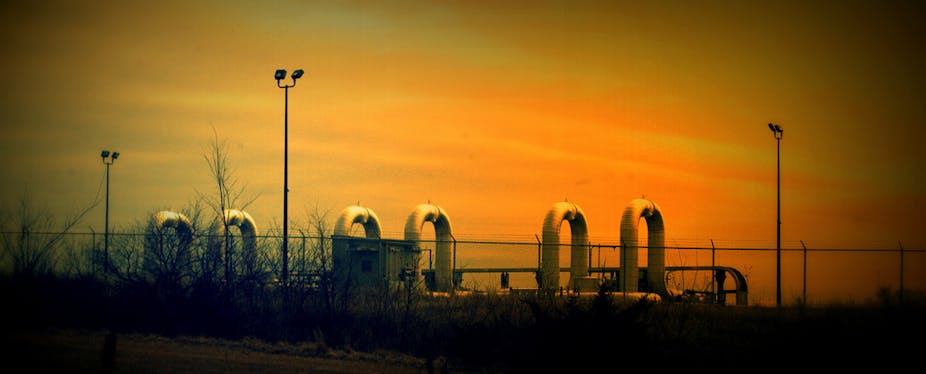In the US, extraction of non-conventional fossil fuels is booming. Investment in extra-heavy and heavy oils, oil shales and sands, tight oil and gas, shale gas and coal seam gas is taking off as companies and US governments look to reap the financial and political benefits.
But the boom comes with major environmental risks, from extraction, transport and fugitive emissions. In fact, just this week we have seen an Exxon oil spill in Arkansas, where an estimated 12,000 barrels of Canadian heavy crude oil were spilt into residential areas near the town of Mayflower from a 65-year-old pipeline.
To date, environmental and safety regulation of these fuels has been grossly inadequate. And yet there is pressure for still more cutting of “green tape”.
Environmental risks of extraction and transport
The threats from extraction are well known, and we’ve seen them in Australia as well as in the US. When under-regulated, the “fracking” process used to release natural gas and tight oil can threaten water quality. A major EPA safety report is due in 2014, but investment isn’t waiting. It’s proceeding strongly under the impetus of both market forces and pressure from the US Federal Government which is keen to encourage gas export, especially as LNG to Europe, to reduce Russia’s influence.
An issue Australia doesn’t face is the risk from heavy, corrosive, carbon-intensive oil from tar sands; in this case, extracted in Canada. In the US, Public concern about the multiple environmental risks associated with the extraction, processing and pipelining of this fuel is focused around a pending Federal decision about the Keystone (XL) pipeline. The State Department’s technical report was released on March 1. The environmental risks of such a pipeline were demonstrated by the Enbridge Energy case of 2010 and this week’s spill in Arkansas.
Apart from profit, potential pipeline approval is again driven by geopolitics. The pipeline would help maintain smooth relations with the Canadian Government but, as some suggest, also provides an alternative to heavy but conventional Venezuelan crude currently refined on the Mexican Gulf coast.
The Keystone pipeline has prompted mass environmental protests. Senior US Federal officials indicate that oil drilling in the North American Arctic may be blocked, with the Obama Administration citing ecological reasons. Though it remains contested, such a ban might be interpreted as a form of political “balance” to a Federal go-ahead for Keystone ─ or simply that the shale boom has put paid (for now) to this high cost Arctic option.
The role of natural gas in reducing emissions
In 2009, President Obama had pledged to reduce America’s energy-sector carbon emissions by 17% from 2005 levels by 2020 rather than the 9% now projected. A US projection suggests carbon emissions from the energy sector will remain lower than the 2005 peak level as far into the future as 2040 - even without any assumed price on such emissions. Significantly, this assumes ongoing replacement of coal-fired generation by gas-fired combined cycle gas turbines (CCGTs). This reduction, still far less ambitious than the 2009 target, reflects continued abundant low-priced gas available from shale. However, there are questions about how long such low US gas prices can be sustained as international market pressures kick in.
CO2 emissions per KWh from combustion of natural gas in gas turbines are often said to be only half those from coal generation. However, intense debate ensues about the role of fugitive methane emissions from (shale) gas extraction - methane being a significantly more potent (but shorter-lived) greenhouse gas than CO2. In the case of internationally traded LNG, full life-cycle emission effects of delivery (pipeline and marine transport, refrigeration and so on) also need to be considered.
The International Energy Agency (IEA) sees natural gas, including non-conventional gas, as a global bridge to reduced emissions, acknowledging a global “golden age” of gas. However, it cautions on the need to apply a set of “golden rules” (strict environmental regulations) if this is to proceed safely and sustainably. Yet, as noted above, this regulation is seriously lagging in the US, as it evidently is in Australia.
Renewables and gas turbines are in many ways technically compatible forms of electricity generation. However, in a climate policy context, the IEA also warns of adverse consequences of low-priced gas expansion for renewable energy if existing government support for renewables were to be precipitately abandoned.
Immediate action needed on climate change risk
The IEA Executive Summary (p.3 of its World Energy Outlook 2012) expresses concern about inadequate national policy responses to mitigating climate change. The IEA’s “450 ppm” scenario sets out the kinds of changing energy mix necessary to achieve the goal of no more than 2°C average global temperature increase by 2050. It notes that if action to reduce CO2 emissions is not taken before 2017, all the allowable emissions would be “locked-in” by the energy infrastructure existing at that time.
This sense of urgency must also apply to the policy context surrounding contentious but diverse forms of non-conventional petroleum. Apart from a sufficient price on greenhouse emissions, at least three priority actions are necessary in the US and internationally:
- tight regulation of fugitive greenhouse emissions from shale gas, and of safety and pollution impacts
- blocking, or pricing out of the market, highly polluting and CO2-intensive sources such as corrosive heavy oil processed from tar sands (discussed further in part 3)
- reducing or stabilising global transport sector use of oil and gas products (whether from conventional or NCP sources) by ending consumer subsidies, ramping up excise tax rates where these are unduly low, and imposing compulsory vehicle fuel efficiency standards.
The IEA’s “450ppm” scenarios require much sharper proportionate reductions from affluent OECD countries, implying only a limited bridging role for gas but an essential role for renewables and for strong improvements in energy efficiency.
This is the second of a three-part series from Barry Naughten. Barry previously discussed US non-conventional petroleum’s economic and geopolitical effects.

